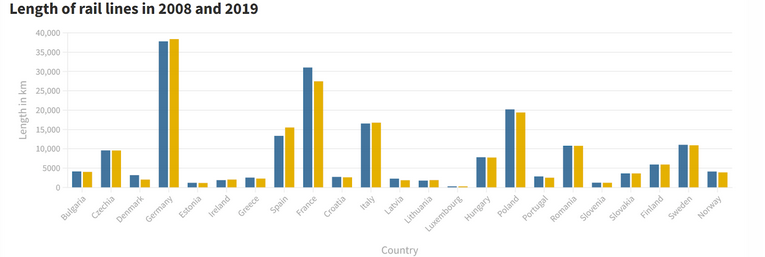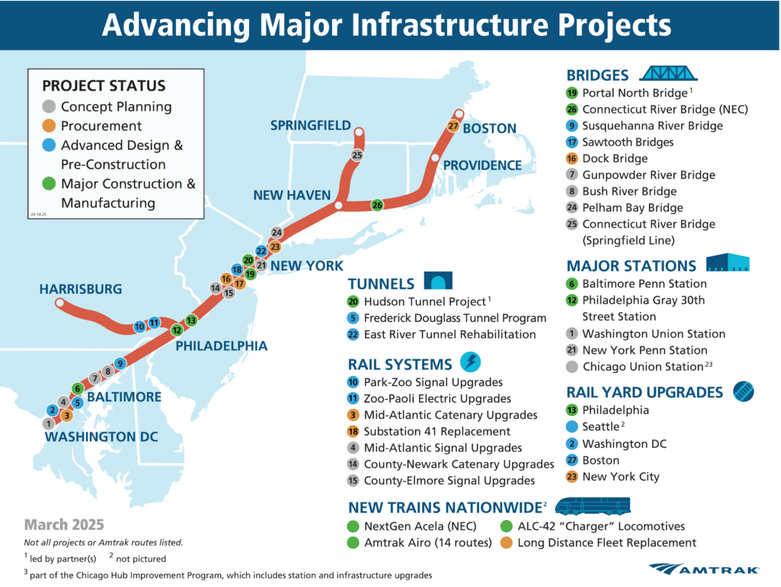US vs EU infrastructure
For the question of why Europe’s infrastructure is so much better than the US we have to consider what perspective we have. As tourists and students studying for a semester we aren’t going to interact with electrical or plumbing related infrastructure that acts behind the scenes as long as it works. The infrastructure we are most concerned about as people traveling is transportation, specifically passenger transportation. With that in mind European passenger infrastructure is much better than the US. It is true that much of the US and European infrastructure is the same age, however they are funded differently and were planned with different priorities in mind.
In the 1950’s the US had a lot of its rail companies go bankrupt and innovation and excitement around cars pushed US cities to invest in more car centric infrastructure and city design, while making already existing rail infrastructure shift towards focussing on long distance freight servicing America’s vast and sparsely populated countryside (Jimenez, 2024, Freight Rail History, n.d.). European cities in the 1950’s had a very different perspective on what transportation infrastructure and city planning was meant to be and focused much more on rebuilding Europe after the war with passenger rails and rebuilding cities that had been destroyed by bombings. Europe did also build large amounts of car centric infrastructure and highways but not to the extent that the US did and has been building and rebuilding their cities to allow for walkability and bikeability (Two Wheels or Two Feet? Making Europe’s Cities More Walkable and Cyclable, 2021). This comes down to the fact that Europe is much more densely populated and can’t afford to have the urban sprawl that the US does and so is forced to invest in ways to make their cities more dense, which often means not prioritizing cars (Conwell et al., 2023).

The US and EU also finance infrastructure projects differently. While both largely rely on private investment and are influenced by market pressures, the EU has more government funding to incentivize new infrastructure projects and maintenance of already existing infrastructure (Larsen, 2024). For example, the US allocated only 11% of its infrastructure budget to rail whereas many EU countries allocate closer to 40% (What Railroad Tracks Mean in the U.S. and Abroad, 2024).

This is not to say that infrastructure in the US is awful and that the EU is amazing. The EU is still not perfect and much of its rail infrastructure is underfunded, even if it is better funded than the US (Schmidt, 2021). And the US is also looking towards expansion with Amtrak’s New Era of Rail initiative looking to double ridership in the US over the next 15 years (Amtrak’s New Era of Rail, 2024).
I, Owen Burry, have found that the EU’s investment in their infrastructure makes travel significantly easier. I was able to go to the Black Forest and back, all in one day, with the use of Germany’s rail infrastructure. I don’t think this venture would be possible back in the United States, as driving is much slower than high-speed rail travel and US rail doesn’t have as much coverage as European rail. On other travels as well, the depth and coverage of European rail and public transit systems is leagues different than the United States.
I, Andy, have found that passenger rail infrastructure in Europe to be more convenient than Amtrak however throughout my semester I have had maintenance related issues with trains getting delayed. This is not a problem unique to one country either. I have had maintenance delays in multiple countries. Certainly Europe’s passenger infrastructure is a step in the right direction but not perfect.
-Andy K. & Owen B.
Sources
Amtrak’s New Era of Rail. (2024). Amtrak’s New Era of Rail. Retrieved April 15, 2025, from https://amtraknewera.com/
Schmidt, N. (2021, November 18). Data Analysis: Trains remain underfunded in Europe. Investigate Europe. Retrieved April 15, 2025, from https://www.investigate-europe.eu/en/posts/despite-public-support-for-rail-trains-remain-underfunded-in-europe
What Railroad Tracks Mean in the U.S. and Abroad. (2024, November 6). National League of Cities. Retrieved April 15, 2025, from https://www.nlc.org/article/2024/11/06/what-railroad-tracks-mean-in-the-u-s-and-abroad/#:~:text=In%202019%2C%20the%20U.S.%20allocated,infrastructure%20spending%20went%20to%20rail
Two wheels or two feet? Making Europe’s cities more walkable and cyclable. (2021, September 30). European Climate Pact. Retrieved April 4, 2025, from https://climate-pact.europa.eu/news-and-events/pact-articles/two-wheels-or-two-feet-making-europes-cities-more-walkable-and-cyclable-2021-09-30_en
Conwell, L., Eckert, F., & Mobarak, A. M. (2023, July). Transportation Infrastructure and City-Center Accessibility in the US and Europe. Fabian Eckert. Retrieved April 15, 2025, from https://fpeckert.me/CEM.pdf
Larsen, M. (2024). Any alternative to the Wall Street Consensus? Comparing the infrastructure financing models of the US, the EU, and China. New Political Economy, 30(1), 34–47. https://doi.org/10.1080/13563467.2024.2373078
Jimenez, E. G. (2024, March 6). US vs EU rail market dynamics. infrata. Retrieved April 15, 2025, from https://infrata.com/news/us-vs-eu-rail-market-dynamics
